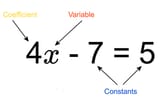Anonymous
6/22/2025, 10:44:37 PM No.16705184
How does a coefficient differ from a variable? Terms are joined by implicit multiplication operations (so 2x^2 is just 2 * x^2), but the commutative property makes the order these appear in purely a matter of convention, so the “It’s the first number in the term” explanation is unsatisfying.
Since the coefficient value itself can be variable in certain contexts, I don’t understand what it is that makes the coefficient a coefficient.
The nearest I got to an explanation was having an LLM explain that the variable is multiplication, whereas the coefficient is scaling, but this didn’t really make any sense to me, since the operations are exactly the same.
Since the coefficient value itself can be variable in certain contexts, I don’t understand what it is that makes the coefficient a coefficient.
The nearest I got to an explanation was having an LLM explain that the variable is multiplication, whereas the coefficient is scaling, but this didn’t really make any sense to me, since the operations are exactly the same.
Replies:
